Comprehensive Analysis of Computer System Architecture & Maintenance
VerifiedAdded on 2024/07/24
|31
|5119
|456
Report
AI Summary
This report provides a comprehensive overview of computer system architecture, starting with the identification and explanation of the main subsystems, including the processor (CPU), main memory, input/output subsystem, and system bus. It delves into the purpose and operation of the CPU, covering instruction cycles and control unit functions. The report also describes various operating systems like Ubuntu and Windows, discussing their purpose, use, and hardware requirements, along with key architectural features. Furthermore, it explains the relationships between hardware and network addresses, detailing their use in networking devices and components, and touches upon setting up and configuring network connectivity. Lastly, the report addresses troubleshooting methods for hardware, software, and networking issues, and documents various maintenance activities for computer hardware and software, concluding with a summary of key findings and recommendations. Desklib offers a variety of study tools and resources for students.
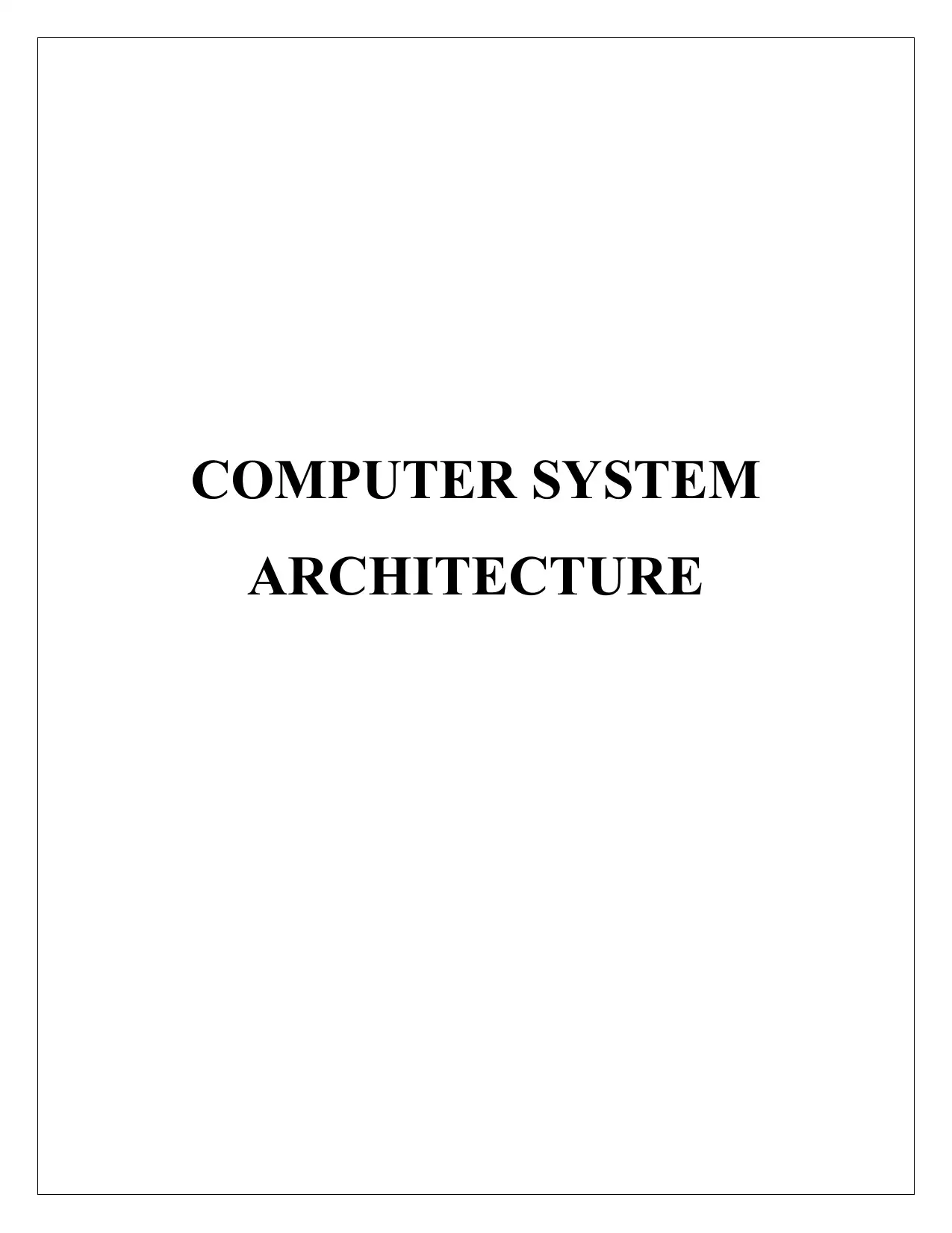
COMPUTER SYSTEM
ARCHITECTURE
ARCHITECTURE
Paraphrase This Document
Need a fresh take? Get an instant paraphrase of this document with our AI Paraphraser
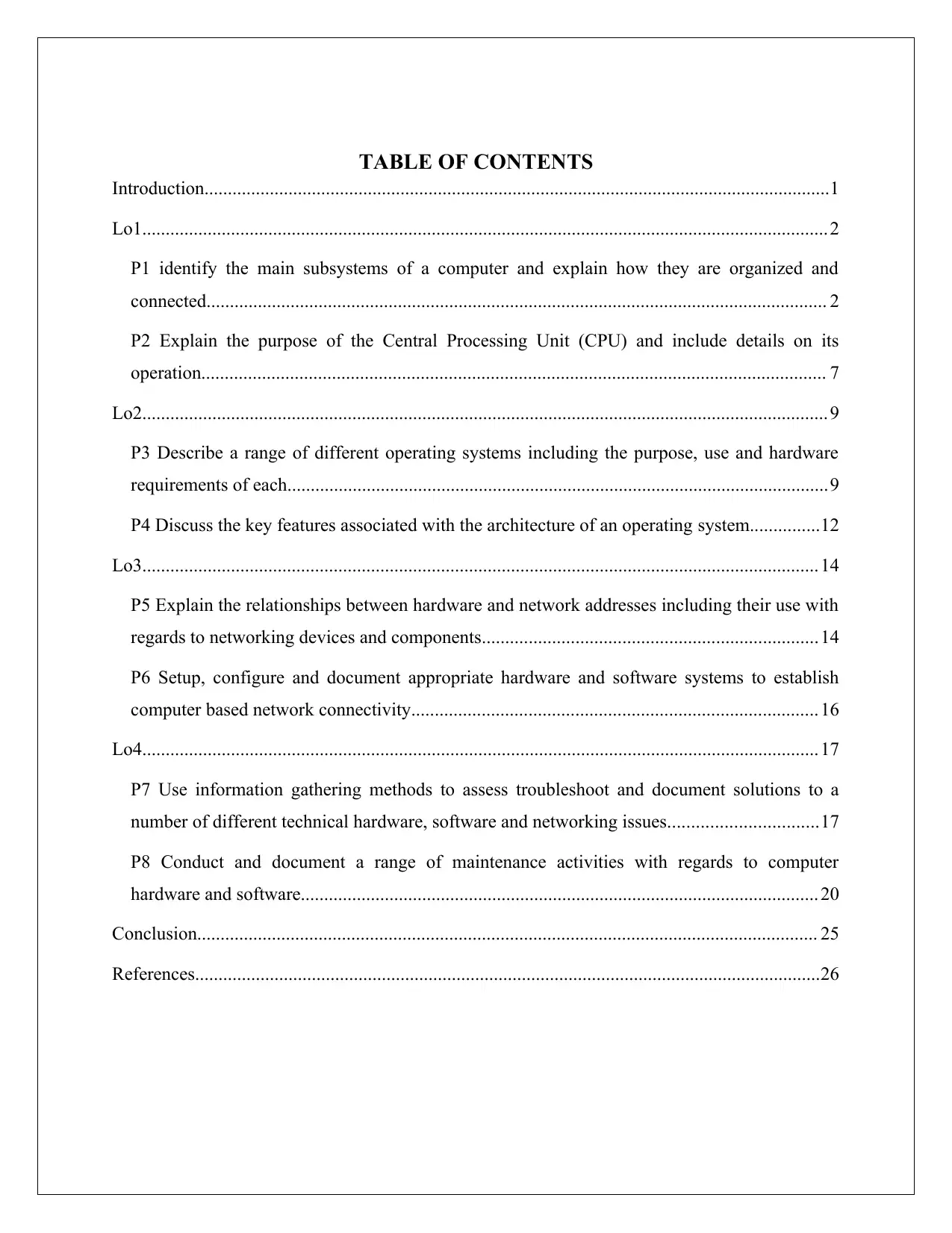
TABLE OF CONTENTS
Introduction......................................................................................................................................1
Lo1................................................................................................................................................... 2
P1 identify the main subsystems of a computer and explain how they are organized and
connected..................................................................................................................................... 2
P2 Explain the purpose of the Central Processing Unit (CPU) and include details on its
operation...................................................................................................................................... 7
Lo2................................................................................................................................................... 9
P3 Describe a range of different operating systems including the purpose, use and hardware
requirements of each....................................................................................................................9
P4 Discuss the key features associated with the architecture of an operating system...............12
Lo3................................................................................................................................................. 14
P5 Explain the relationships between hardware and network addresses including their use with
regards to networking devices and components........................................................................14
P6 Setup, configure and document appropriate hardware and software systems to establish
computer based network connectivity....................................................................................... 16
Lo4................................................................................................................................................. 17
P7 Use information gathering methods to assess troubleshoot and document solutions to a
number of different technical hardware, software and networking issues................................17
P8 Conduct and document a range of maintenance activities with regards to computer
hardware and software............................................................................................................... 20
Conclusion..................................................................................................................................... 25
References......................................................................................................................................26
Introduction......................................................................................................................................1
Lo1................................................................................................................................................... 2
P1 identify the main subsystems of a computer and explain how they are organized and
connected..................................................................................................................................... 2
P2 Explain the purpose of the Central Processing Unit (CPU) and include details on its
operation...................................................................................................................................... 7
Lo2................................................................................................................................................... 9
P3 Describe a range of different operating systems including the purpose, use and hardware
requirements of each....................................................................................................................9
P4 Discuss the key features associated with the architecture of an operating system...............12
Lo3................................................................................................................................................. 14
P5 Explain the relationships between hardware and network addresses including their use with
regards to networking devices and components........................................................................14
P6 Setup, configure and document appropriate hardware and software systems to establish
computer based network connectivity....................................................................................... 16
Lo4................................................................................................................................................. 17
P7 Use information gathering methods to assess troubleshoot and document solutions to a
number of different technical hardware, software and networking issues................................17
P8 Conduct and document a range of maintenance activities with regards to computer
hardware and software............................................................................................................... 20
Conclusion..................................................................................................................................... 25
References......................................................................................................................................26

LIST OF TABLES
Table 1: Department and IP addresses...........................................................................................16
Table 2: Common computer system issue along with measures...................................................18
Table 1: Department and IP addresses...........................................................................................16
Table 2: Common computer system issue along with measures...................................................18
⊘ This is a preview!⊘
Do you want full access?
Subscribe today to unlock all pages.

Trusted by 1+ million students worldwide

LIST OF FIGURES
Figure 1: Interaction between different subsystems of a computer.................................................2
Figure 2: Central processing Unit....................................................................................................3
Figure 3: Memory Hierarchy........................................................................................................... 4
Figure 4: Input/output Subsystem....................................................................................................5
Figure 5: CPU organization along with System bus........................................................................6
Figure 6: Phases of Instruction Cycle.............................................................................................. 7
Figure 7: Ubuntu desktop.............................................................................................................. 10
Figure 8: Window 10 Screenshot.................................................................................................. 11
Figure 9: Operating Systems Architecture....................................................................................12
Figure 10: Monolithic, Microkernel and Hybrid operating sytsem...............................................13
Figure 11: Setting Up a Computer network...................................................................................16
Figure 12: File explorer.................................................................................................................21
Figure 13: C: drive of the computer..............................................................................................21
Figure 14: Drive to optimise..........................................................................................................22
Figure 15: Select drive for its optimization...................................................................................22
Figure 16: fragmentation Percentage.............................................................................................23
Figure 17: Scanning the system with Antivirus.............................................................................24
Figure 1: Interaction between different subsystems of a computer.................................................2
Figure 2: Central processing Unit....................................................................................................3
Figure 3: Memory Hierarchy........................................................................................................... 4
Figure 4: Input/output Subsystem....................................................................................................5
Figure 5: CPU organization along with System bus........................................................................6
Figure 6: Phases of Instruction Cycle.............................................................................................. 7
Figure 7: Ubuntu desktop.............................................................................................................. 10
Figure 8: Window 10 Screenshot.................................................................................................. 11
Figure 9: Operating Systems Architecture....................................................................................12
Figure 10: Monolithic, Microkernel and Hybrid operating sytsem...............................................13
Figure 11: Setting Up a Computer network...................................................................................16
Figure 12: File explorer.................................................................................................................21
Figure 13: C: drive of the computer..............................................................................................21
Figure 14: Drive to optimise..........................................................................................................22
Figure 15: Select drive for its optimization...................................................................................22
Figure 16: fragmentation Percentage.............................................................................................23
Figure 17: Scanning the system with Antivirus.............................................................................24
Paraphrase This Document
Need a fresh take? Get an instant paraphrase of this document with our AI Paraphraser
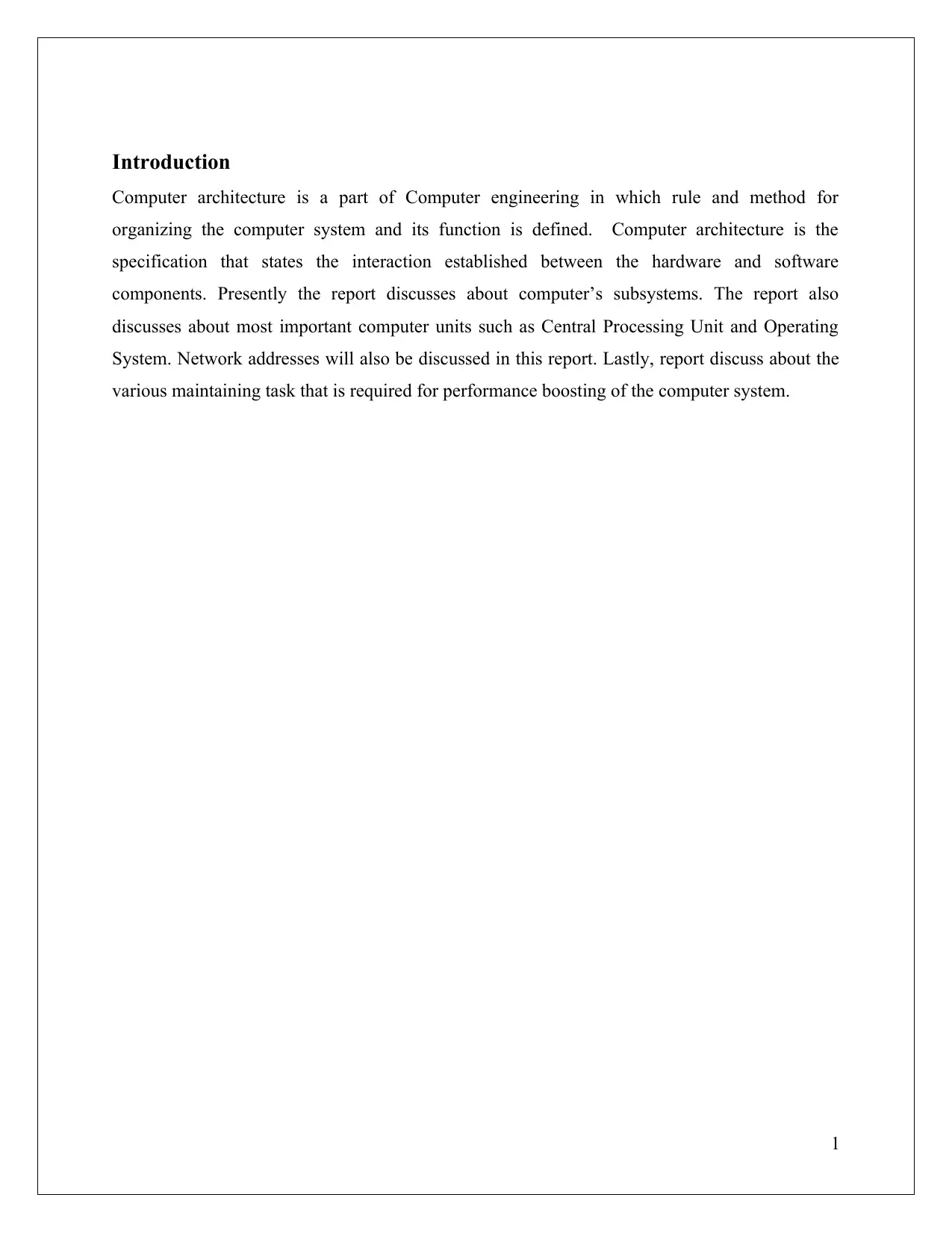
Introduction
Computer architecture is a part of Computer engineering in which rule and method for
organizing the computer system and its function is defined. Computer architecture is the
specification that states the interaction established between the hardware and software
components. Presently the report discusses about computer’s subsystems. The report also
discusses about most important computer units such as Central Processing Unit and Operating
System. Network addresses will also be discussed in this report. Lastly, report discuss about the
various maintaining task that is required for performance boosting of the computer system.
1
Computer architecture is a part of Computer engineering in which rule and method for
organizing the computer system and its function is defined. Computer architecture is the
specification that states the interaction established between the hardware and software
components. Presently the report discusses about computer’s subsystems. The report also
discusses about most important computer units such as Central Processing Unit and Operating
System. Network addresses will also be discussed in this report. Lastly, report discuss about the
various maintaining task that is required for performance boosting of the computer system.
1
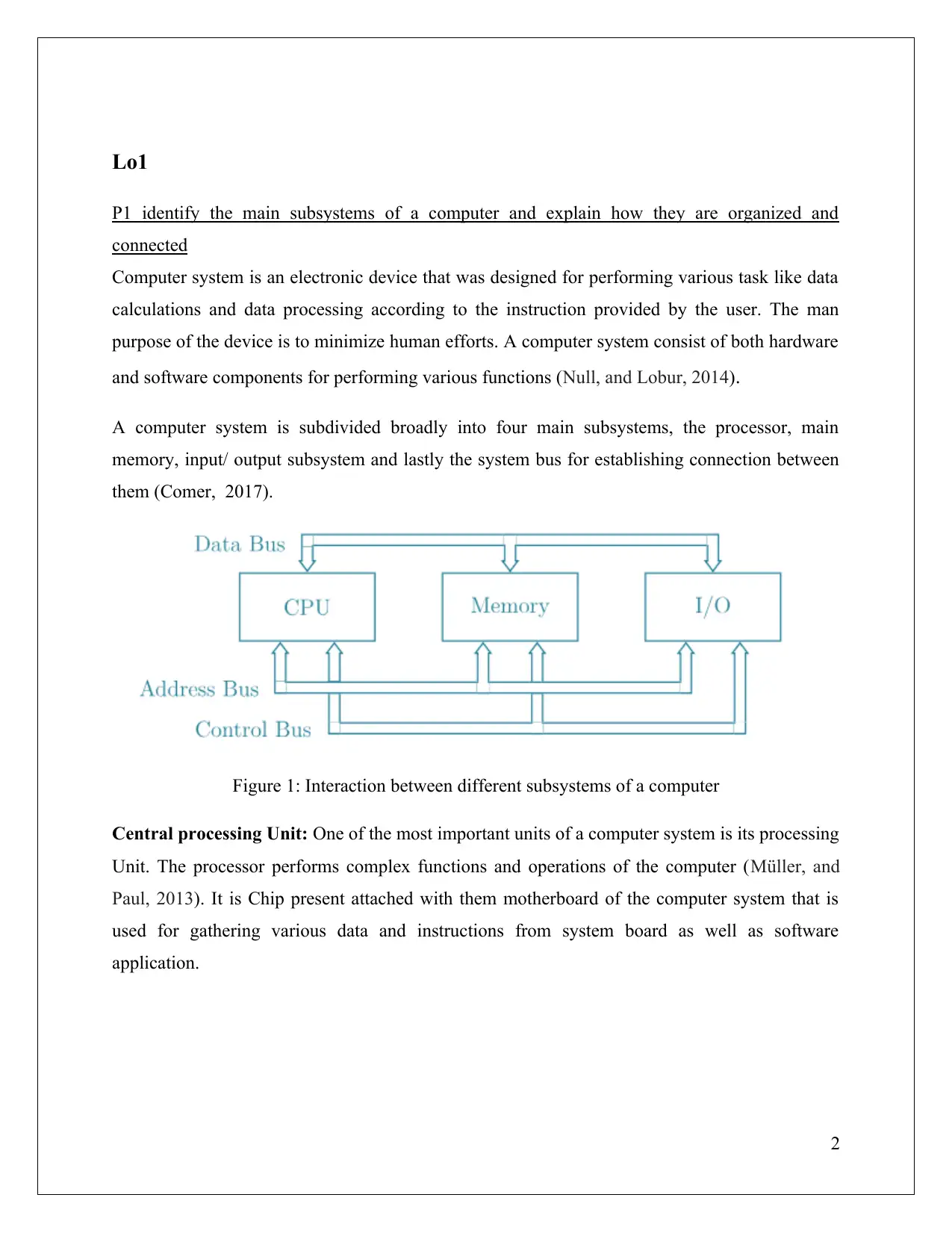
Lo1
P1 identify the main subsystems of a computer and explain how they are organized and
connected
Computer system is an electronic device that was designed for performing various task like data
calculations and data processing according to the instruction provided by the user. The man
purpose of the device is to minimize human efforts. A computer system consist of both hardware
and software components for performing various functions (Null, and Lobur, 2014).
A computer system is subdivided broadly into four main subsystems, the processor, main
memory, input/ output subsystem and lastly the system bus for establishing connection between
them (Comer, 2017).
Figure 1: Interaction between different subsystems of a computer
Central processing Unit: One of the most important units of a computer system is its processing
Unit. The processor performs complex functions and operations of the computer (Müller, and
Paul, 2013). It is Chip present attached with them motherboard of the computer system that is
used for gathering various data and instructions from system board as well as software
application.
2
P1 identify the main subsystems of a computer and explain how they are organized and
connected
Computer system is an electronic device that was designed for performing various task like data
calculations and data processing according to the instruction provided by the user. The man
purpose of the device is to minimize human efforts. A computer system consist of both hardware
and software components for performing various functions (Null, and Lobur, 2014).
A computer system is subdivided broadly into four main subsystems, the processor, main
memory, input/ output subsystem and lastly the system bus for establishing connection between
them (Comer, 2017).
Figure 1: Interaction between different subsystems of a computer
Central processing Unit: One of the most important units of a computer system is its processing
Unit. The processor performs complex functions and operations of the computer (Müller, and
Paul, 2013). It is Chip present attached with them motherboard of the computer system that is
used for gathering various data and instructions from system board as well as software
application.
2
⊘ This is a preview!⊘
Do you want full access?
Subscribe today to unlock all pages.

Trusted by 1+ million students worldwide
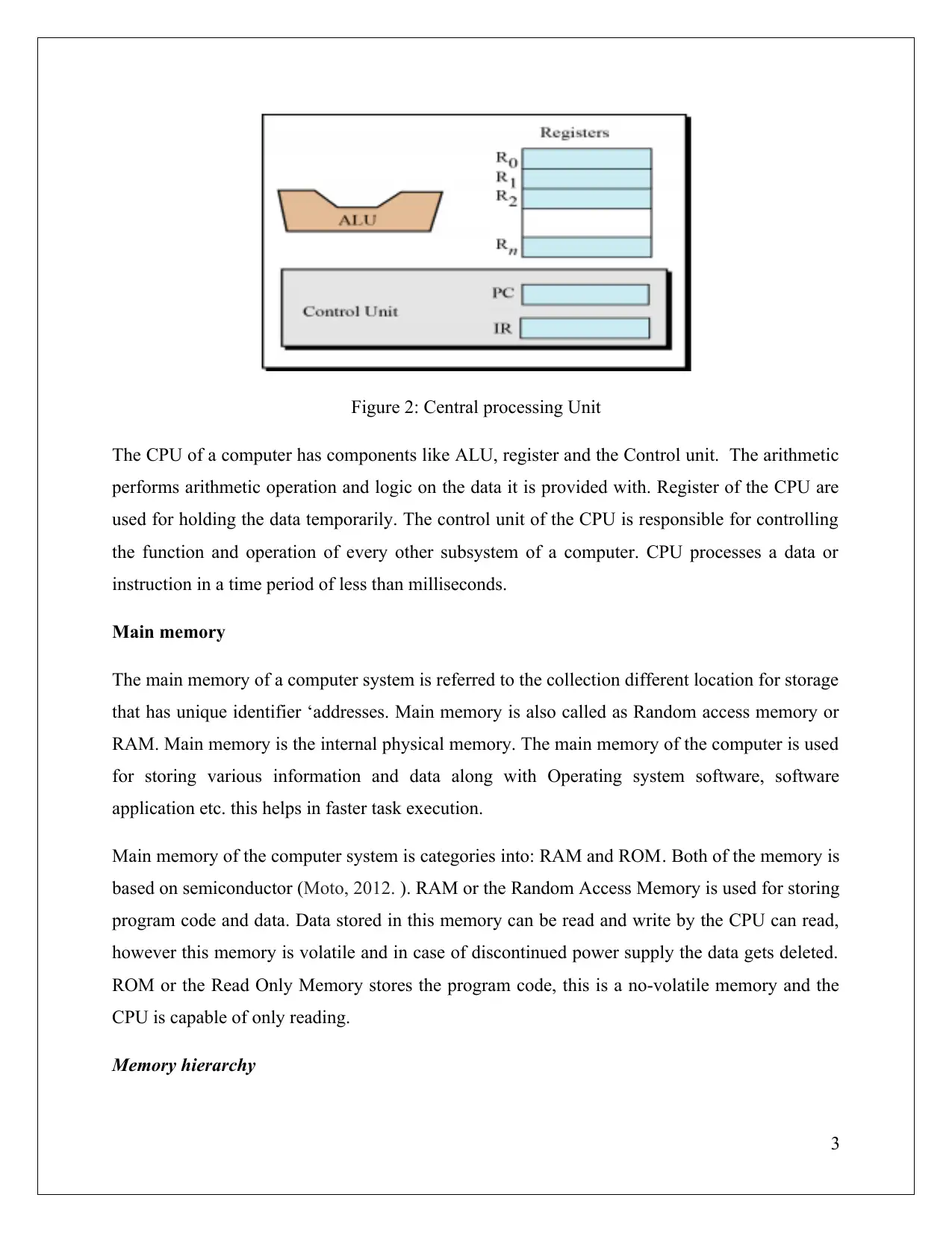
Figure 2: Central processing Unit
The CPU of a computer has components like ALU, register and the Control unit. The arithmetic
performs arithmetic operation and logic on the data it is provided with. Register of the CPU are
used for holding the data temporarily. The control unit of the CPU is responsible for controlling
the function and operation of every other subsystem of a computer. CPU processes a data or
instruction in a time period of less than milliseconds.
Main memory
The main memory of a computer system is referred to the collection different location for storage
that has unique identifier ‘addresses. Main memory is also called as Random access memory or
RAM. Main memory is the internal physical memory. The main memory of the computer is used
for storing various information and data along with Operating system software, software
application etc. this helps in faster task execution.
Main memory of the computer system is categories into: RAM and ROM. Both of the memory is
based on semiconductor (Moto, 2012. ). RAM or the Random Access Memory is used for storing
program code and data. Data stored in this memory can be read and write by the CPU can read,
however this memory is volatile and in case of discontinued power supply the data gets deleted.
ROM or the Read Only Memory stores the program code, this is a no-volatile memory and the
CPU is capable of only reading.
Memory hierarchy
3
The CPU of a computer has components like ALU, register and the Control unit. The arithmetic
performs arithmetic operation and logic on the data it is provided with. Register of the CPU are
used for holding the data temporarily. The control unit of the CPU is responsible for controlling
the function and operation of every other subsystem of a computer. CPU processes a data or
instruction in a time period of less than milliseconds.
Main memory
The main memory of a computer system is referred to the collection different location for storage
that has unique identifier ‘addresses. Main memory is also called as Random access memory or
RAM. Main memory is the internal physical memory. The main memory of the computer is used
for storing various information and data along with Operating system software, software
application etc. this helps in faster task execution.
Main memory of the computer system is categories into: RAM and ROM. Both of the memory is
based on semiconductor (Moto, 2012. ). RAM or the Random Access Memory is used for storing
program code and data. Data stored in this memory can be read and write by the CPU can read,
however this memory is volatile and in case of discontinued power supply the data gets deleted.
ROM or the Read Only Memory stores the program code, this is a no-volatile memory and the
CPU is capable of only reading.
Memory hierarchy
3
Paraphrase This Document
Need a fresh take? Get an instant paraphrase of this document with our AI Paraphraser
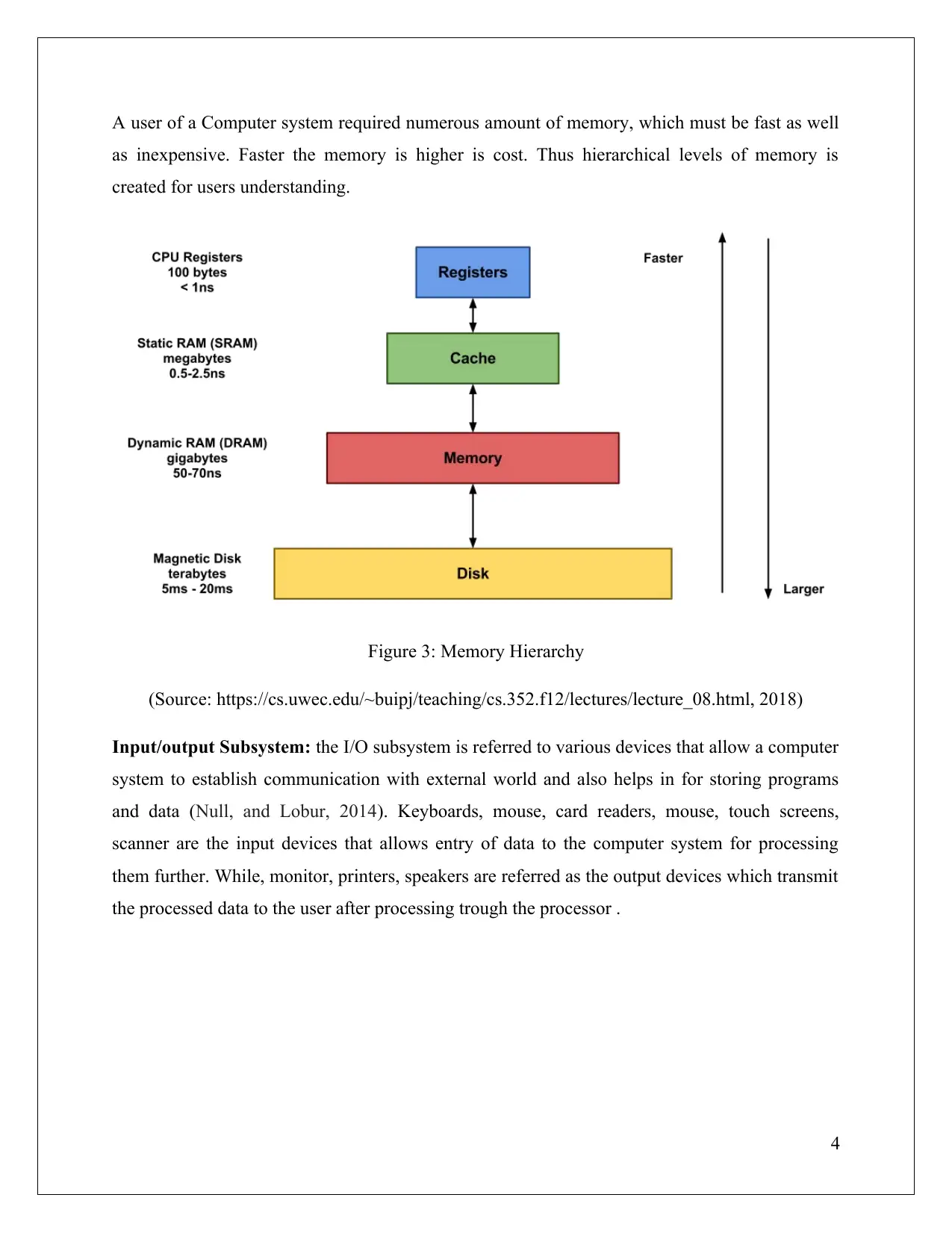
A user of a Computer system required numerous amount of memory, which must be fast as well
as inexpensive. Faster the memory is higher is cost. Thus hierarchical levels of memory is
created for users understanding.
Figure 3: Memory Hierarchy
(Source: https://cs.uwec.edu/~buipj/teaching/cs.352.f12/lectures/lecture_08.html, 2018)
Input/output Subsystem: the I/O subsystem is referred to various devices that allow a computer
system to establish communication with external world and also helps in for storing programs
and data (Null, and Lobur, 2014). Keyboards, mouse, card readers, mouse, touch screens,
scanner are the input devices that allows entry of data to the computer system for processing
them further. While, monitor, printers, speakers are referred as the output devices which transmit
the processed data to the user after processing trough the processor .
4
as inexpensive. Faster the memory is higher is cost. Thus hierarchical levels of memory is
created for users understanding.
Figure 3: Memory Hierarchy
(Source: https://cs.uwec.edu/~buipj/teaching/cs.352.f12/lectures/lecture_08.html, 2018)
Input/output Subsystem: the I/O subsystem is referred to various devices that allow a computer
system to establish communication with external world and also helps in for storing programs
and data (Null, and Lobur, 2014). Keyboards, mouse, card readers, mouse, touch screens,
scanner are the input devices that allows entry of data to the computer system for processing
them further. While, monitor, printers, speakers are referred as the output devices which transmit
the processed data to the user after processing trough the processor .
4
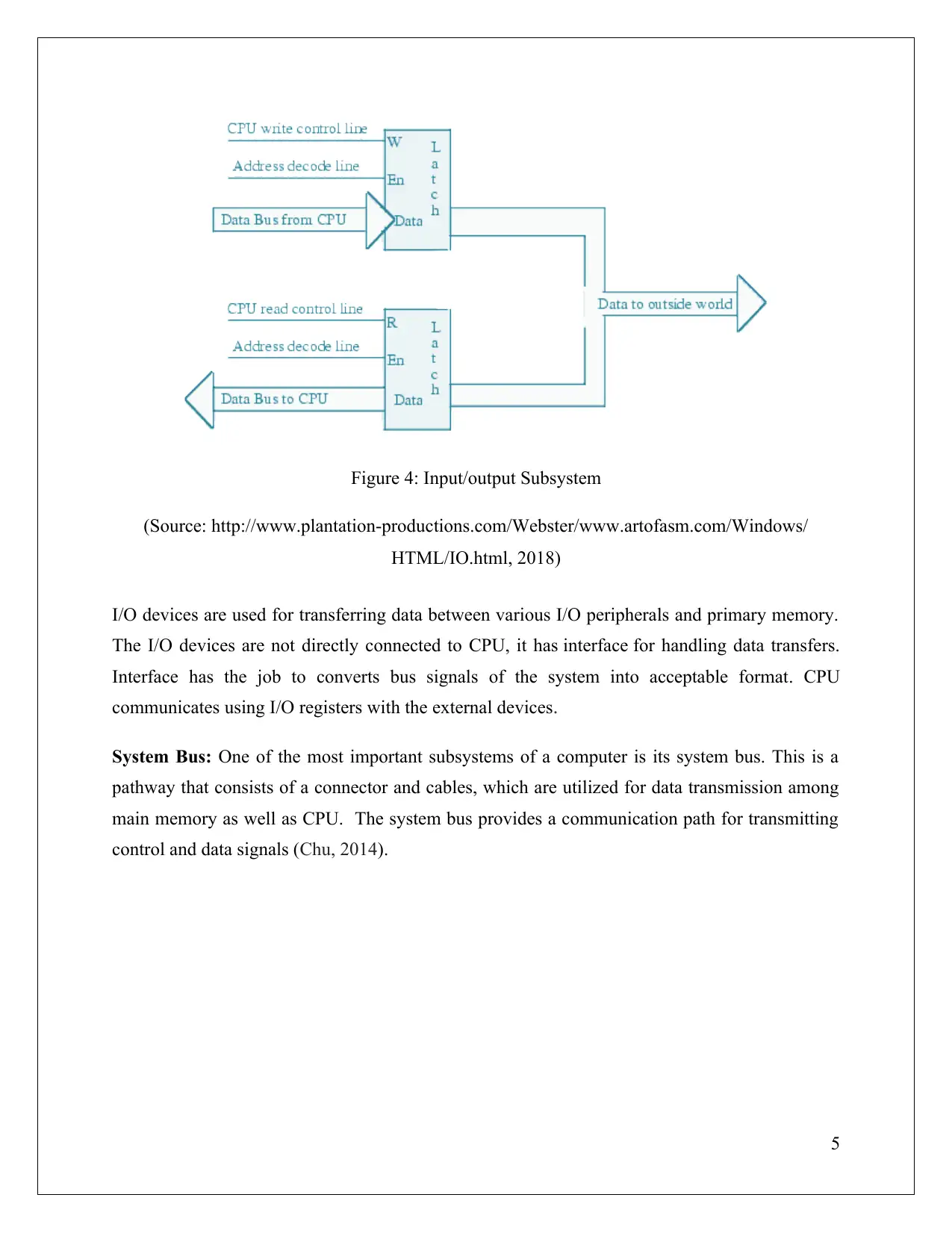
Figure 4: Input/output Subsystem
(Source: http://www.plantation-productions.com/Webster/www.artofasm.com/Windows/
HTML/IO.html, 2018)
I/O devices are used for transferring data between various I/O peripherals and primary memory.
The I/O devices are not directly connected to CPU, it has interface for handling data transfers.
Interface has the job to converts bus signals of the system into acceptable format. CPU
communicates using I/O registers with the external devices.
System Bus: One of the most important subsystems of a computer is its system bus. This is a
pathway that consists of a connector and cables, which are utilized for data transmission among
main memory as well as CPU. The system bus provides a communication path for transmitting
control and data signals (Chu, 2014).
5
(Source: http://www.plantation-productions.com/Webster/www.artofasm.com/Windows/
HTML/IO.html, 2018)
I/O devices are used for transferring data between various I/O peripherals and primary memory.
The I/O devices are not directly connected to CPU, it has interface for handling data transfers.
Interface has the job to converts bus signals of the system into acceptable format. CPU
communicates using I/O registers with the external devices.
System Bus: One of the most important subsystems of a computer is its system bus. This is a
pathway that consists of a connector and cables, which are utilized for data transmission among
main memory as well as CPU. The system bus provides a communication path for transmitting
control and data signals (Chu, 2014).
5
⊘ This is a preview!⊘
Do you want full access?
Subscribe today to unlock all pages.

Trusted by 1+ million students worldwide
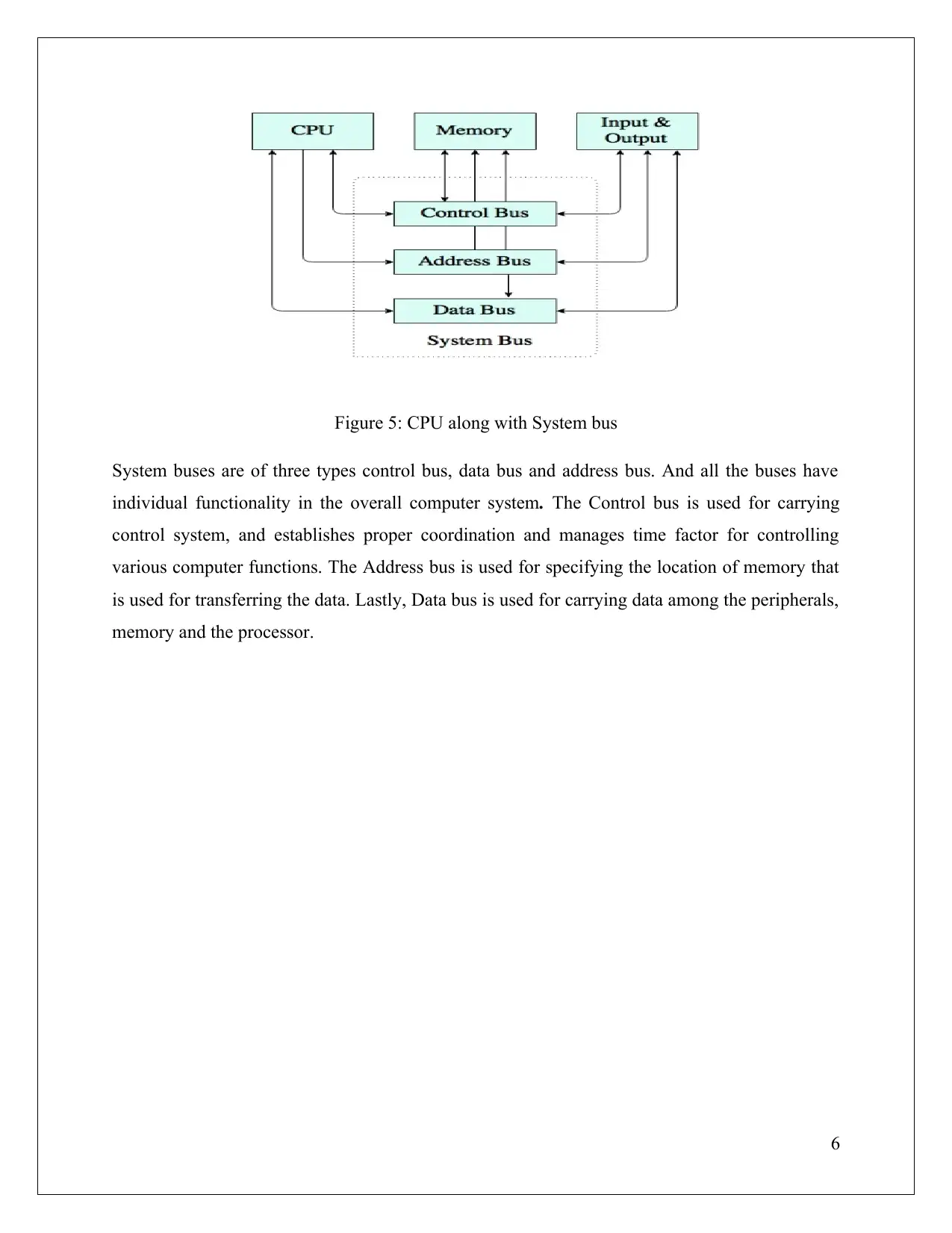
Figure 5: CPU along with System bus
System buses are of three types control bus, data bus and address bus. And all the buses have
individual functionality in the overall computer system. The Control bus is used for carrying
control system, and establishes proper coordination and manages time factor for controlling
various computer functions. The Address bus is used for specifying the location of memory that
is used for transferring the data. Lastly, Data bus is used for carrying data among the peripherals,
memory and the processor.
6
System buses are of three types control bus, data bus and address bus. And all the buses have
individual functionality in the overall computer system. The Control bus is used for carrying
control system, and establishes proper coordination and manages time factor for controlling
various computer functions. The Address bus is used for specifying the location of memory that
is used for transferring the data. Lastly, Data bus is used for carrying data among the peripherals,
memory and the processor.
6
Paraphrase This Document
Need a fresh take? Get an instant paraphrase of this document with our AI Paraphraser
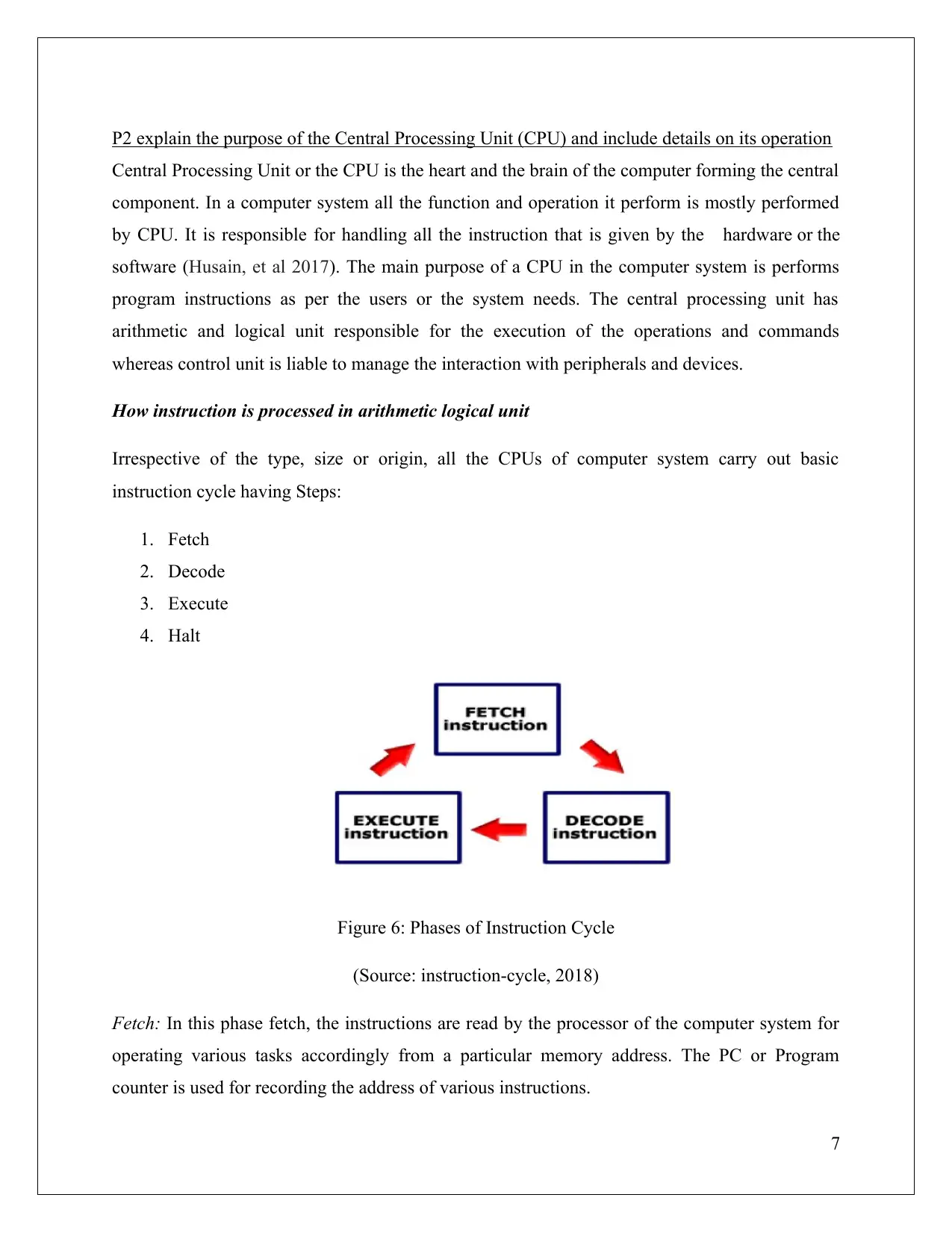
P2 explain the purpose of the Central Processing Unit (CPU) and include details on its operation
Central Processing Unit or the CPU is the heart and the brain of the computer forming the central
component. In a computer system all the function and operation it perform is mostly performed
by CPU. It is responsible for handling all the instruction that is given by the hardware or the
software (Husain, et al 2017). The main purpose of a CPU in the computer system is performs
program instructions as per the users or the system needs. The central processing unit has
arithmetic and logical unit responsible for the execution of the operations and commands
whereas control unit is liable to manage the interaction with peripherals and devices.
How instruction is processed in arithmetic logical unit
Irrespective of the type, size or origin, all the CPUs of computer system carry out basic
instruction cycle having Steps:
1. Fetch
2. Decode
3. Execute
4. Halt
Figure 6: Phases of Instruction Cycle
(Source: instruction-cycle, 2018)
Fetch: In this phase fetch, the instructions are read by the processor of the computer system for
operating various tasks accordingly from a particular memory address. The PC or Program
counter is used for recording the address of various instructions.
7
Central Processing Unit or the CPU is the heart and the brain of the computer forming the central
component. In a computer system all the function and operation it perform is mostly performed
by CPU. It is responsible for handling all the instruction that is given by the hardware or the
software (Husain, et al 2017). The main purpose of a CPU in the computer system is performs
program instructions as per the users or the system needs. The central processing unit has
arithmetic and logical unit responsible for the execution of the operations and commands
whereas control unit is liable to manage the interaction with peripherals and devices.
How instruction is processed in arithmetic logical unit
Irrespective of the type, size or origin, all the CPUs of computer system carry out basic
instruction cycle having Steps:
1. Fetch
2. Decode
3. Execute
4. Halt
Figure 6: Phases of Instruction Cycle
(Source: instruction-cycle, 2018)
Fetch: In this phase fetch, the instructions are read by the processor of the computer system for
operating various tasks accordingly from a particular memory address. The PC or Program
counter is used for recording the address of various instructions.
7
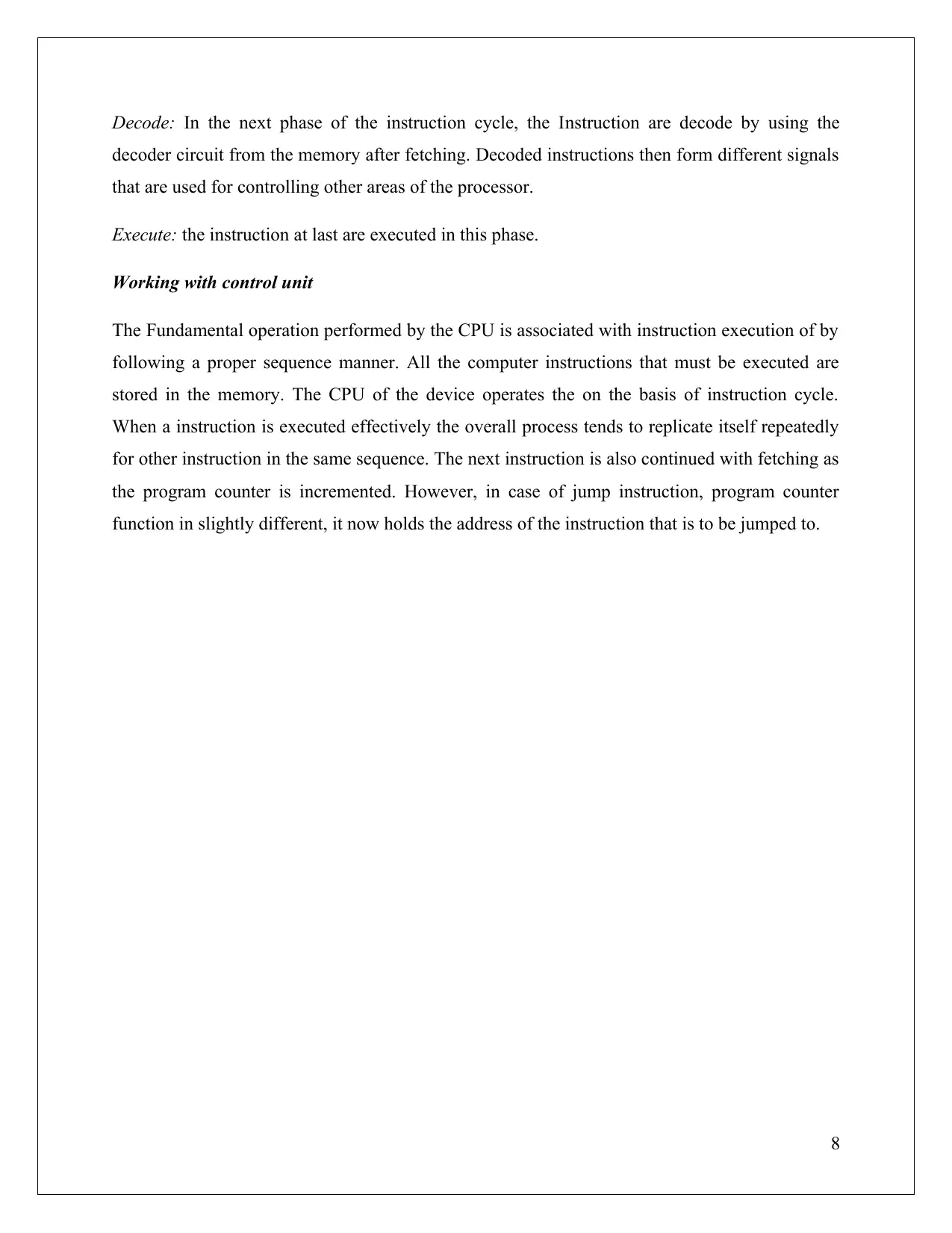
Decode: In the next phase of the instruction cycle, the Instruction are decode by using the
decoder circuit from the memory after fetching. Decoded instructions then form different signals
that are used for controlling other areas of the processor.
Execute: the instruction at last are executed in this phase.
Working with control unit
The Fundamental operation performed by the CPU is associated with instruction execution of by
following a proper sequence manner. All the computer instructions that must be executed are
stored in the memory. The CPU of the device operates the on the basis of instruction cycle.
When a instruction is executed effectively the overall process tends to replicate itself repeatedly
for other instruction in the same sequence. The next instruction is also continued with fetching as
the program counter is incremented. However, in case of jump instruction, program counter
function in slightly different, it now holds the address of the instruction that is to be jumped to.
8
decoder circuit from the memory after fetching. Decoded instructions then form different signals
that are used for controlling other areas of the processor.
Execute: the instruction at last are executed in this phase.
Working with control unit
The Fundamental operation performed by the CPU is associated with instruction execution of by
following a proper sequence manner. All the computer instructions that must be executed are
stored in the memory. The CPU of the device operates the on the basis of instruction cycle.
When a instruction is executed effectively the overall process tends to replicate itself repeatedly
for other instruction in the same sequence. The next instruction is also continued with fetching as
the program counter is incremented. However, in case of jump instruction, program counter
function in slightly different, it now holds the address of the instruction that is to be jumped to.
8
⊘ This is a preview!⊘
Do you want full access?
Subscribe today to unlock all pages.

Trusted by 1+ million students worldwide
1 out of 31
Related Documents
Your All-in-One AI-Powered Toolkit for Academic Success.
+13062052269
info@desklib.com
Available 24*7 on WhatsApp / Email
![[object Object]](/_next/static/media/star-bottom.7253800d.svg)
Unlock your academic potential
Copyright © 2020–2025 A2Z Services. All Rights Reserved. Developed and managed by ZUCOL.


![Operating System Architecture Report - [University Name], Semester 1](/_next/image/?url=https%3A%2F%2Fdesklib.com%2Fmedia%2Foperating-system-architecture-guide_page_2.jpg&w=256&q=75)


